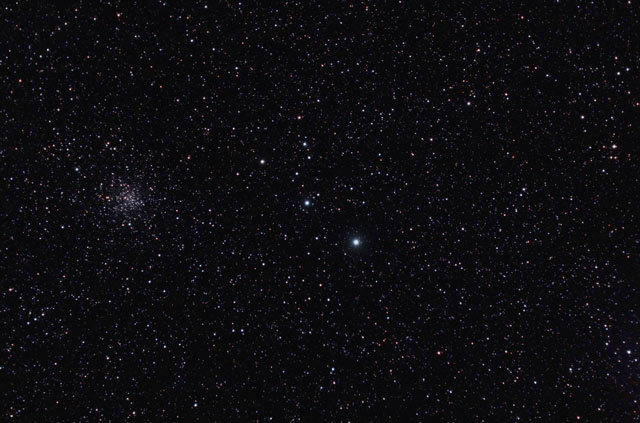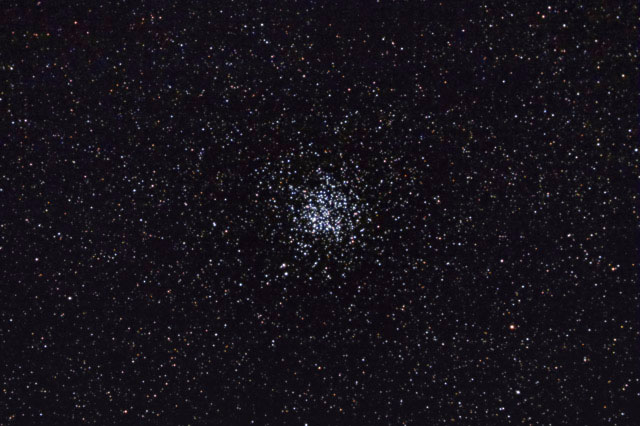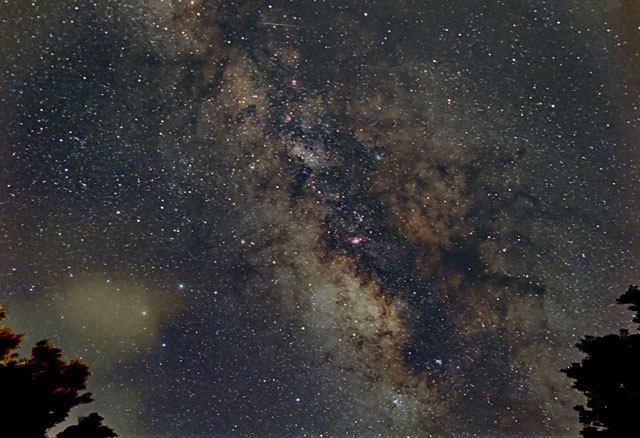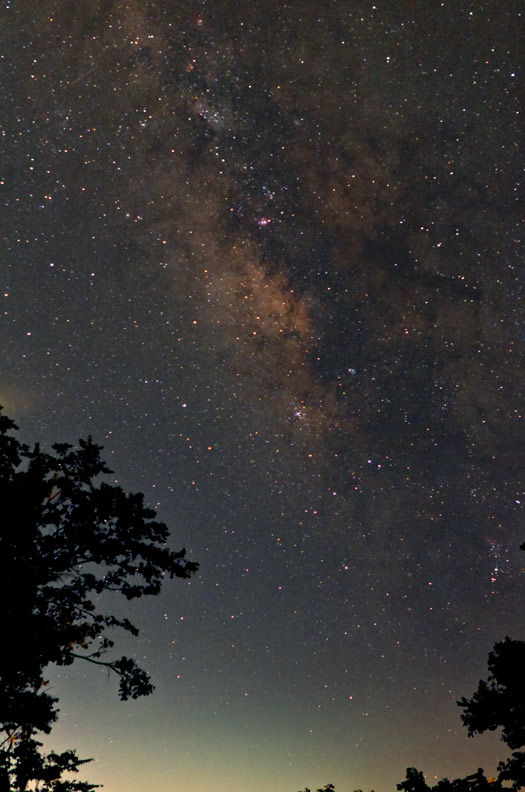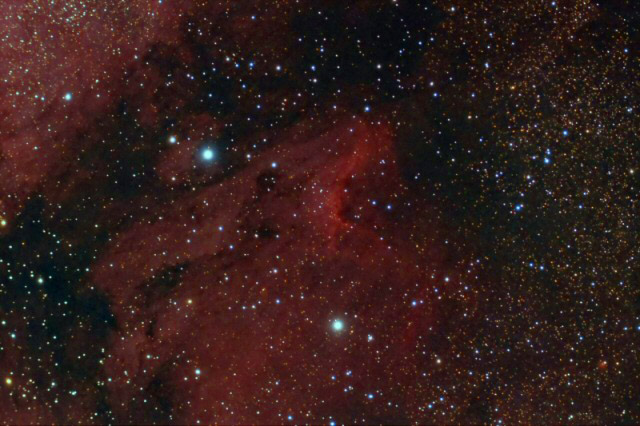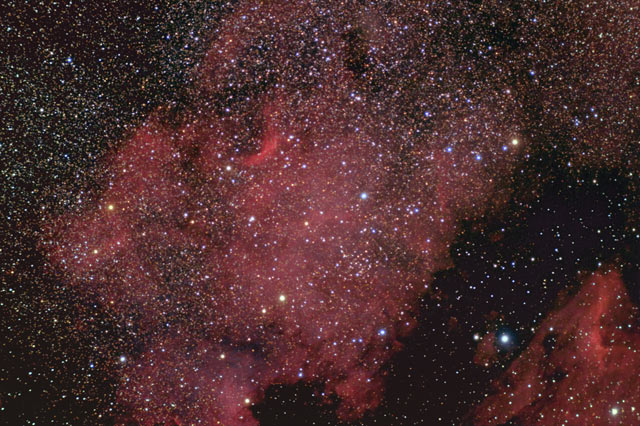______________________
M71 Globular Cluster
On 8/3/06
|
August started out much like July
with hazy conditions and lots of clouds. I did not give up very
easily and tried to take pictures every chance I got. |
|
M71, Globular Cluster in Sagitta on 8/3/06. Taken with a Celestron C-8 at F/5.8 (1160mm,) and a Baader MPCC. Guided with a Meade DSI and 100mm F/5 refractor. Camera is a Hutech Type 1 modified Canon 350 XT. Exposure was 11x150 second sub-images at 1600 ISO. Processed and stacked in IRIS with dark, flat and bias calibration. Photoshop, RC-Astro's Gradient XTerminator and Noel Carboni's Astronomy Tools for post processing. Neat Image for noise reduction. Click here to see the full size hi-res version. |
______________________
M11, The Wild Duck Cluster
On 8/3/06
|
Not to be stopped be a few clouds, I imaged M11 after the skies deteriorated somewhat after imaging M71, above. |
|
M11, The Wild Duck Cluster on 8/3/06. Taken with a Celestron C-8 at F/5.8 (1160mm,) and a Baader MPCC. Guided with a Meade DSI and 100mm F/5 refractor. Camera is a Hutech Type 1 modified Canon 350 XT. Exposure was 7x30 second sub-images at 1600 ISO. Processed and stacked in IRIS with dark, flat and bias calibration. Photoshop, RC-Astro's Gradient XTerminator and Noel Carboni's Astronomy Tools for post processing. Neat Image for noise reduction. Click here to see the full size hi-res version. |
______________________
The Milky Way, Wide Field Images
on 8/14/06
|
What can you image with just a
camera with a wide angle lens and a tripod? The Milky Way,
that's what! I just love taking images like this.
|
|
The Milky Way on 8/14/06. Taken with a Hutech Type 1 modified Canon 350 XT, 28-70mm Sigma Zoom at 28mm F/2.8 and F/4. Exposure for the first image was 3x30 second sub-images at 1600 ISO. The second image was 1x20 sec at F/4 and 1600 ISO. Processed and stacked in IRIS with dark, flat and bias calibration. Photoshop, RC-Astro's Gradient XTerminator and Noel Carboni's Astronomy Tools for post processing. Neat Image for noise reduction. |
______________________
First Light - Astro-Tech 66mm F/6,
Atlas EQ-G Goto Mount:
M31, The Andromeda Galaxy
|
The newest items in my imaging
equipment arsenal are a 66mm F/6 ED (Semi-APO) refractor and an Orion
Atlas EQ-G equatorial mount. The refractor is manufactured by
Astro-Tech and is similar to other small 66mm APO-type scopes.
|
|
M31, The Andromeda Galaxy on 8/28/06. Taken with a Astro-Tech 66mm F/6 ED refractor and a Hutech Type 1 modified Canon 350 XT. Exposure was 16x120 second sub-images at ISO 1600. Processed and stacked in IRIS with dark, flat and bias calibration. Photoshop, RC-Astro's Gradient XTerminator and Noel Carboni's Astronomy Tools for post processing. Neat Image for noise reduction. Click here to see the full size hi-res version. |
______________________
The Pelican Nebula
on 8/30/06
|
I had a chance to shoot more images using the new 66mm F/6 Apo refractor on 8/30/06. Here is the Pelican Nebula, which is right next to the North America Nebula in Cygnus. |
|
The Pelican Nebula on 8/30/06. Taken with a Astro-Tech 66mm F/6 ED refractor and a Hutech Type 1 modified Canon 350 XT. Exposure was 20x150 second sub-images at ISO 800. Processed and stacked in IRIS with dark, flat and bias calibration. Photoshop, RC-Astro's Gradient XTerminator and Noel Carboni's Astronomy Tools for post processing. Neat Image for noise reduction. Click here to see the full size hi-res version. |
______________________
The North America Nebula
on 8/31/06
|
With all the new equipment, I figured it would be best to test different guiding software packages and see how well each performed. For this session, I decided that I would guide with my DSI camera and Meade's Envisage software. My target was the North America Nebula. After a few frustrating hours chasing equipment bugs, I finally got everything working. |
|
The North America Nebula on 8/31/06. Taken with a Astro-Tech 66mm F/6 ED refractor and a Hutech Type 1 modified Canon 350 XT. Exposure was 30x180 second sub-images at ISO 800. Processed and stacked in IRIS with dark, flat and bias calibration. Photoshop, RC-Astro's Gradient XTerminator and Noel Carboni's Astronomy Tools for post processing. Neat Image for noise reduction. Click here to see the full size hi-res version. |
All Images Copyright © 2006 Mike Broussard.
All rights reserved.
To send comments or for more information, please email me at
mike@synergyitg.com.
Visitors since August 1, 2006
